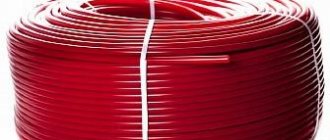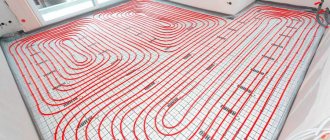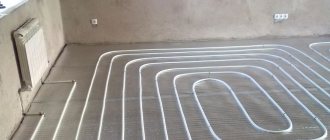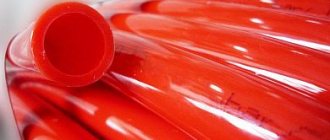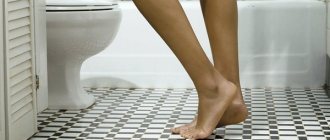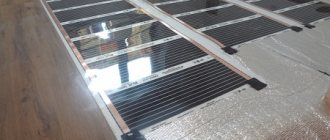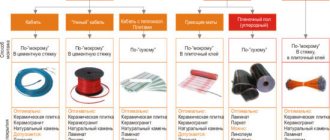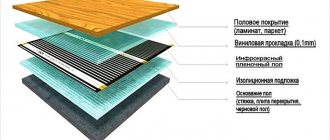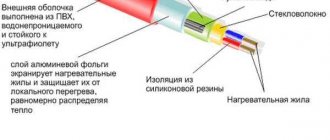The underfloor heating system underfloor heating has recently gained great popularity, especially in the construction of new houses. This system was first used in Ancient Rome. The Romans used stone pillars with slabs to create gaps through which warm air could spread. The underfloor heating system offers a complete solution for creating the ideal comfort zone in any conditions. Pipes are one of the main parts warm floor. It is very important that they are of good quality, have ideal technical characteristics, are installed correctly and do not cause problems during further operation.
When installing heated floors, the following
types of pipes :
- copper
- steel corrugated
- polypropylene
- metal-plastic
- cross-linked polyethylene pipes
At the moment, the most common are metal-plastic pipes and pipes made of cross-linked polyethylene (REX), in contrast to expensive copper and corrugated steel.
Metal-plastic pipes
Metal-plastic pipes (MP) are multilayer composite pipes consisting of five layers. The inner and outer layers of polyethylene are tightly connected to the inner layer of special aluminum foil using glue.
This complex pipe has been developed specifically for underfloor heating to offer optimal efficiency in terms of heating output per m², achieving uniform heating of the floor surface with a minimum number of pipes. The aluminum layer results in faster heating times. The inner wall of the pipes is smooth, so calcification does not occur , and the pipes are not subject to corrosion. The unique combination of aluminum and polyethylene ensures durability and provides an alternative to copper pipes. Metal-plastic pipes have their advantages and disadvantages. There are a number of reasons why MP pipes are the best heated floor pipes available.
Advantages of metal-plastic pipes
The advantages of MP pipes include the following characteristics:
- anti-oxygen protection to prevent corrosion of metal parts of the system, such as, for example, a boiler;
- low linear expansion coefficient;
- resistance to corrosion , as well as to chemicals;
- good sound insulation ;
- smooth surface ( less pressure loss );
- keep their shape;
- durability - tests have shown that the service life is up to 50 years and above.
- maximum operating temperature at a pressure of 10 bar up to 95 ºС;
- convenient installation , since MP pipes are easily bent. This allows them to be evenly laid in snakes and spirals with a large number of folds.
The connection of MP pipes is made using various fitting systems using special tools: press jaws, shears for MP pipes, reamers for pipe processing, crimping machine and others.
Disadvantages of metal-plastic
The disadvantages of pipes include the following:
- different linear expansion coefficients for aluminum and polyethylene, which can lead to delamination of pipes;
- when using threaded fittings, scale may build up on the inside of the fittings, so it is better to use press fittings;
- If the fittings are pinched during installation, a cut may appear on the pipe.
Criterias of choice
When choosing a material for the construction of communications, the decisive argument should not be considerations of economic benefit or installation complexity, but the compliance of the technical characteristics of the pipes with the expected operating conditions.
In the case of installing heated floors, the following requirements apply to pipe materials:
- Durability . According to official requirements for pipes for heated floors, it is prohibited to use ferrous rolled metal and seamed pipes. Steel products without special anti-corrosion protection in a walled-up state will not last long. The connecting seam is a “weak” point when hydraulic pressure increases in the heating system. The use of such materials will quickly lead to an emergency situation, the elimination of which will require opening the concrete screed.
- Chemical inertness . For long-term operation without reducing the internal clearance, pipes with a perfectly smooth inner wall are required. The coolant contains salts of alkaline earth metals, which, during long-term operation, are deposited on the inner walls of most pipe materials.
- Resistance to mechanical loads without deformation . The minimum concrete screed exerts a pressure on the pipes equal to 10 kg of weight per square meter. cm. Soft plastic pipes will be deformed under this load, and too hard plastic may burst.
- Resistance to high temperature and pressure of the carrier in the heating system . The minimum required stability parameters are 95 degrees and 10 atm. respectively.
- High level of heat transfer . For efficient heating, it is important that communications are not a barrier between the coolant and the air.
- No connections under the screed . Pipe materials are required that can be laid in one piece up to 120 m long.
- Flexibility and fracture resistance . When laying heated floors, it is important that the pipes are flexible enough to bend without damaging the walls and deforming the internal section with a minimum radius. Large distances between pipes cause cold segments.
We recommend that you familiarize yourself with: Hot-deformed seamless steel pipe
The choice of this or that material is also influenced by the type of heating in the house. If this is a central system, then the heated floor will be subject to more severe loads than with an individual circuit.
Note! Those looking for the ideal option for underfloor heating should consider using copper materials. Copper has a much greater safety margin than is necessary in this case. There are two disadvantages - complicated installation and high price of copper pipes.
Metal-plastic and cross-linked polyethylene are very close in their technical and price characteristics. Comparing their positive and negative sides will allow you to make the right choice in each specific case.
XLPE pipes
XLPE pipes - REX pipes . REX is an abbreviation for cross-linked polyethylene. This flexible, durable material is becoming an increasingly popular material. To give polyethylene strength and resistance to temperature influences, it is processed under high pressure. This leads to the formation of additional molecular bonds . This processing method is called *cross-linking*, which is why polyethylene is called cross-linked polyethylene.
Due to the three-dimensional molecular bonding in the structure of polyethylene, there are a number of advantages compared to traditional metal pipes. Three-dimensional molecular bonding increases the resistance of pipes to thermal deformation, abrasion, scratches, shrinkage, and cracking due to internal stress.
When choosing REX pipes, you should pay attention to the degree of crosslinking . The standard requires a certain degree of cross-linking, at least 65%, ranging from 65% to 80%. The stitching method affects the service life and technical characteristics, as well as the cost of the pipes.
There are three methods for producing cross-linked polyethylene, which affect the degree of cross-linking.
- Pyroxide (REX - a) - pyroxides are introduced into polyethylene. The degree of crosslinking is up to 85%.
- Silane (REX - b) - organosilanides are added to polyethylene. The degree of crosslinking is at least 65%.
- Radiation (REX - c) - degree of crosslinking 60%.
If the degree of crosslinking is 0%, then the pipes become too brittle and prone to cracking. Too little stitching can have equally serious consequences.
Pros of REX pipes
REX pipes have a number of advantages :
- low noise level of pipes due to its flexibility and ability to absorb pressure surges;
- ease;
- ease of installation;
- have *shape memory* , can easily restore their original shape;
- corrosion resistance;
- durability , operation is designed for a period of at least 50 years;
- resistance to freezing in cold weather;
- flexibility;
- minimal probability of *explosions* after defrosting the system;
- withstand high temperature and pressure changes.
XLPE pipes are affordable .
REX pipes are installed using specialized fittings. This allows you to significantly reduce hydraulic losses in the pipeline. The life of the underfloor heating system is increased because fewer fittings are used at kinks, which reduces the risk of leaks and costly repairs in the future.
Polyethylene pipes
Cross-linked polyethylene is a modern high-tech chemical product. Cross-linking of the polymer occurs at the molecular level. Ordinary polyethylene is a long linear chain of molecules. Modern technologies allow chemists to link these molecules together with strong additional chemical bonds. Just as threads form strong fabric, linear molecules form a three-dimensional web of cross-linked polyethylene.
There are several technologies for the production of cross-linked polyethylene. They differ in their cost, percentage of connected linear molecules at the output, and labeling. To install a heated floor, pipes with a crosslinking percentage of at least 65% are required.
PEX-a pipes have up to 85% cross-linked molecules. Their production process is quite expensive, but guarantees high-quality material. The technology for producing PEX-b pipes is cheaper, but produces only 65% of the connected molecules.
Note! Pipes marked PEX-c for floor insulation are not reliable enough.
The best properties of polyethylene pipes:
- High elasticity – allows pipes to be laid as close to each other as possible without damage.
- Low expansion coefficient. Cross-linked polyethylene does not “walk” under concrete when the temperature changes. Resistance to mechanical influences from outside and outside. The material does not deform under the concrete screed and does not burst when frozen with water.
- The ability to return to its original form. This guarantees tightness when using fittings and no deformation at the bend.
- Inert to chemical and biological influences. Pipes do not rot or be destroyed by aggressive environments.
- Compliance of the technical characteristics of the material with operating conditions. Cross-linked polyethylene can withstand water heating up to 90 degrees (recommended temperature 80) and pressure up to 8 atm.
We recommend that you read: How to insulate a chimney pipe efficiently and safely?
Cross-linked polyethylene has few disadvantages and they are related to installation. The high elasticity of the material in bending requires pipelayers to rigidly fix the pipes during installation. The second point is the need to preserve the external protective coating. This makes the work somewhat more complicated compared to metal-plastic.
Pipe overview
When laying the heated floor contour, the following is used:
- metal-plastic pipes;
- polyethylene pipes with increased heat resistance PE-RT type I and II;
- pipes made of cross-linked polyethylene PE-X.
Moreover, PE-RT type II and PE-X pipes may or may not have an EVOH oxygen protective layer.
Let's take a look at the thermal conductivity of pipes for water heated floors. So:
- Metal-plastic - 0.43;
- PE-RT type II - 0.38;
- PE-X - 0.35.
Directly in the case of warm water floors, these are very good indicators, indicating full heat transfer into the screed. Note that polypropylene has a thermal conductivity of 0.24. There is a clear difference in heat transfer rates, but it is insignificant. Despite this, a metal-plastic pipe heats the floor a little faster than polyethylene pipes. But this indicator no longer affects a further decrease in temperature.
Since the heat transfer of metal-plastic is slightly increased, this can be explained by the presence of an aluminum layer with high thermal conductivity. That is why the pipe is called “metal-plastic”. And the polymer layers in this type of pipe are PE-RT or PE-X. This is determined by the manufacturer's brand.
Metal-plastic pipe products for floor insulation
Metal-plastic pipes were originally developed for constructing closed floor insulation systems. These materials have a complex, multilayer structure, where the supporting element is aluminum foil. Adding metal to cross-linked polyethylene eliminates its disadvantages, but adds its own characteristics that should be taken into account during installation.
To understand how a metal-plastic pipe works, you need to understand its structure. The material is a “sandwich” of two layers of polyethylene covered with metal. The bonding agent is a special glue that is applied to the metal foil on both sides.
Aluminum inclusion adds metal-plastic to all the advantages of polyethylene pipes:
- resistance to water hammer;
- higher operating parameters - pressure up to 10 atm, temperature up to 95-100 degrees (recommended 93);
- faster and more efficient heating of the room;
- the ability to maintain the bending shape without fixation, which simplifies installation.
When choosing high-quality pipes, you will not encounter any disadvantages. Poor-quality metal-plastic can create problems during installation. A poor adhesive base leads to delamination of the pipe, and thin foil will quickly break at a break.
Note! Installation of a metal-plastic floor is carried out at a distance of 35 cm. Closer installation will lead to deformation of the pipe at the bend.
